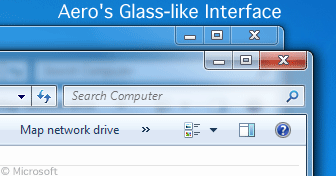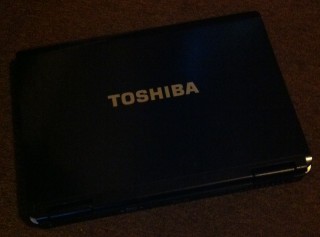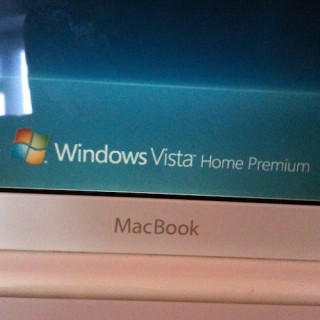I am a Mac user and have been for over a decade. No matter how much Windows changes, it will never be enough to pull me away from the beauty that is Mac OS X. But does Vista deserve the stick it gets?
My household is of mixed computers, which gives me the chance to have a various operating systems including: Mac OS X 10.9 Mavericks, 10.6 Snow Leopard, and System 7, as well as Windows XP and Windows 8, prior to which was running Windows Vista. I even have a machine running ElementaryOS.
Now, before you all recoil in horror – and that includes a lot of Windows fans – does Windows Vista really really deserve the flack that it has been saddled with?
Compared to Windows XP, which was released in 2001, Vista (released in 2006) really was a heavier OS, partly due to its major new overhauled fancier interface. It made for some horror stories in the media, Microsoft have always understated their minimum requirement, and for anyone who has tried to run Vista on an the “Vista Capable” 800 MHz Pentium 4 with 512 MB RAM will see how much it crawls. Even the “Vista Ready” 1 GHz with 1 GB RAM didn’t exactly bring the best out in your computer.
Poor hardware support from manufacturers was another reason for its poor performance and uptake. The introduction of User Account Control (UAC) and the poor gaming support were further reasons people didn’t like it over XP.
If you bought a Vista machine, it would have the relevant drivers, but upgrading from XP or fresh installing on a custom built machine could bring in driver issues. However, with subsequent updates from Microsoft and better drivers from manufacturers, the experience became better and better. The release of faster computers eased the poor performance of Vista.
 Vista in 2007
Vista in 2007
My first experience was with a brand new Toshiba Satellite in 2007. The fluid flowing OS was pretty enough to look at – especially compared to the horribly garish Windows XP, but simple things like browsing would crash a brand new Core Duo laptop – and even upping the RAM from 1 GB to 2 GB made little difference. It was this kind of experience that put people off from upgrading. After all, Windows users were used to running a 6-year-old OS that was designed to initially run on a 233 MHz Pentium with 64 MB RAM, by which time despite bloating with three Services Packs would still run on a modest machine.
 However, fellow Low End Mac writer Andrew Fishkin mentioned in his 2008 article Vista Can Offer Comparable Performance and Reliability to Mac OS X that pre-installed bloatware by manufacturers such as Toshiba probably accounted for the poor performance of Vista as well as poor graphic chips not fully capable of supporting its Aero graphics.
However, fellow Low End Mac writer Andrew Fishkin mentioned in his 2008 article Vista Can Offer Comparable Performance and Reliability to Mac OS X that pre-installed bloatware by manufacturers such as Toshiba probably accounted for the poor performance of Vista as well as poor graphic chips not fully capable of supporting its Aero graphics.
A clean install using a retail Windows disc is always recommended; it puts nothing but Windows on, and while you might need to do some digging to get all the hardware drivers installed correctly, it offers a better Windows experience. This is something you don’t have to worry about with Mac OS X.
Fishkin’s article was a response to my Leopard on an 867 MHz G4 Trounces Vista on a 2 GHz Core Duo Notebook.
Vista in 2012
In 2012, I bought a Vista disc very cheaply, which I presume is partly down to people not liking Vista and because others had upgraded to Windows 7. I installed it on a 2 GHz Core 2 Duo tower with 3 GB of RAM and a 1 GB video card, and the performance was amazing.
Update: I was running the 64-bit version on this Core 2 Duo tower. It seems a lot more stable than 32-bit version.
Is this experience different to my 2007 experience just due to better hardware? Or is some of it because it was a clean, fresh install with no pre-installed manufacturers software or trial software?
Vista in 2013

In 2013, I was given a very sick Toshiba laptop to clean up, and I decided it would be quicker to wipe the hard drive and reinstall Vista on it, as it came with a disc and COA. It was a 1.6 GHz Core Duo machine with 1 GB RAM. I was quite dubious whether this would be sufficient to run Vista well enough – especially after my horrible experience in 2007 on similar hardware – but after the reinstall it bounced along very well, and after upgrading it to 2 GB of RAM it positively screamed along.
Subsequent years of updates and improved drivers made the experience much more stable than my experience in 2007. This coupled again by better hardware and a clean install. It was only to be used for web surfing and Facebook games – the latter can be quite taxing on moderate hardware – but it has thrown up zero problems, and performance is brilliant.
Vista in a Virtual Machine

I even installed Vista on my Early 2009 MacBook as a virtual machine using VirtualBox. Despite it being virtualised, it ran very well and was perfectly usable. It was only out of curiousity, however, so was wiped off later.
From Vista to Windows 8
The Core 2 Duo tower, which belongs to my kids, was running Vista very well. The large amount of RAM and fairly powerful graphics card lent itself to the beast that is Vista.
Early in 2013, Microsoft were offering ridiculously low upgrade prices from earlier versions of Windows to Windows 8. After serious consideration, I took advantage of the £24.99 budget price tag before the offer ran out.
I upgraded from Vista 64-bit (which is much faster and more stable than the 32-bit version) to Windows 8 64-bit.
Windows 7 was a huge streamline and speed increase over Vista, and Windows 8 further improves this. So jumping from Vista straight to Windows 8, the performance increase and stability was instantly noticeable – and amazing to watch.
Windows 8 is a huge jump in terms of looks and interface. I personally do not like it, dumbing it down it looks like a child’s interface and trying to blend the new tile interface with the old Windows style just doesn’t gel well. The Windows 8.1 update goes some way to rectify this, but not enough.
Downgrade to Vista?
After causing a severe problem where Windows 8 failed to boot, I had to do a reinstall. Being an upgrade, I had to install Vista first and then upgrade to Windows 8, and after installing Vista, I seriously considered sticking with it. I had forgotten how straightforward and traditional Vista was compared to 8.
However, in the interest of future proofing – and the fact that I paid for it – I continued to upgrade to Windows 8.
Vista Statistics
Despite it being a good OS, it really has suffered numbers-wise. Looking at the traffic coming in to Low End Mac, Vista peaked at 19.5% in April 2010, sitting now at only 3.5% and dropping, compared to Windows 7 at 65%, XP at 17%, and Windows 8 at 12.4%.
Conclusion
I’m a Mac user, and I’m a Linux fan. If I didn’t have a Mac, I would use Linux, purely because I cannot stand using Windows on a daily basis. It just frustrates me. But as someone who has used every version of Windows since 3.11, Vista really isn’t that bad.
Windows 2000 was possibly the best version of Windows ever, but it is too old and now unsupported. Windows XP mainstream support ended 2009.04.14, with extended support due to end 2014.04.08, putting it officially in the unsupported category.
Vista mainstream support ended 2012.04.10, but extended support is not due to end until 2017.04.11.
If you have the option of running Windows 7 or 8, I suggest you do it for better support. Both are faster operating systems, but Vista is still very capable and very useable.
If you are going to use Vista, make sure you have as much RAM as you can get your hands on and do a fresh install. Also be careful which anti-virus and anti-spyware protection you install, as some can be fairly resource heavy.
For further reading, take a look at Dan Knight’s article The Future of Windows Vista, an overview of Windows XP, Vista, and 7 and whether Windows 8 will follow in the downward path of Vista or the success of XP and 7.
Follow Simon Royal on Twitter or send him an Email.
Like what you have read? Send Simon a donation via Tip Jar.
keywords: #vista #windows #microsoft #techspectrum #simonroyal
short link: http://goo.gl/lxJ7jw
searchword: vistareputation


Besides enough RAM the other hardware-related issue that troubled Vista – and helped lead to its bad reputation – was graphics-based. Many systems – particularly low-end ones – in 2006/07 had very poor graphics subsystems (often Intel-built). It was clear prior to the Vista release that they would run badly at best and not be able to display Vista’s Aero graphics – transparent task bar, menu bars, etc.
Prior to the Vista release, Intel (apparently) pressured Microsoft to ensure that these systems would be able to be sold as Vista-compatible.
At the time (mid-2006), I was shopping for a new laptop, at least in part to be able to run Vista… I got a Dell Insipron 6400, paying a premium for a dedicated ATI graphics card with extra video RAM, and maxxed out the system RAM. The result – it ran Vista very well. My son has it now – following a hard drive crash we re-installed Vista – and it’s still fast and attractive.
I run vista 32 on daily basis with a gaming PC I built at 2004. It was a beastly machine back then. P4 northwood 2600 Radeon 9700 pro graphics. Used to run a pirated copy of XP on it but in 07 it got a major infection that I couldn´t get rid so I decided to run an original OS instead and get updates as I didn´t had time, still dont, do deal with workarounds.
Bought a copy of vista with the intention of calling microsoft and rolling back to XP. Never did. Still using the same installation btw. It takes 15 minutes to cold boot but if you hibernate, only 2 minutes and its on rock solid.
People forget that XP SP0 was equally bad. I consider XP SP2 a brand new OS as it was a 260 MB download. After ME fiasco I understand why it was given for free, it´s happening again with Win 8.
Vista from SP1 works great but 1GB of ram is not enough at least 1.5GB. 2GB is even better. System idles at 1GB, if you want to get some work done it needs more.
I waiting for this system to toast so I buy a new one. I completely stopped playing games altogether. I´ll keep using this as long as it works. It does its job fine.
There were other things that caused the initial bad press with Vista, we bought a pretty high spec laptop for the time in February 2007, 4GB RAM and checked it over once Vista’s installation was complete and Vista showed it had less than 128MB free…
Checked services and running applications, disabled everything I felt was not necessary, rebooted and… 102MB free… Rebuilt, re-configured, re-checked… 89MB free…
What Vista was doing was grabbing all available memory and using it as a giant cache but every time an application was started, the memory had to be swapped out, making this new fast laptop a slow slouch when starting things up, especially compared to the 2 year old PC’s running XP.
It’s not like Microsoft were not warned either. I’d been working at a company with access to developer versions of Vista and it was obvious 12 months before release that there were going to be issues, but the warnings were ignored as “Most users will be upgrading machines to the problems will be fixed with the upgrade to a faster machine”, as history shows they didn’t.
Vista SP1 cured a lot of issues, but a lot of the problems could have been avoided in the first place. Better memory management, less eye candy, fewer animations that become annoying because your stuck looking at them while the machine struggles to do what XP could do quicker, but more importantly, listen to the developer and testing community that were flagging these issues up long before it got into public hands. All of the above gave Vista a troubled start and it is much harder to fix a bad reputation than it is to gain one.